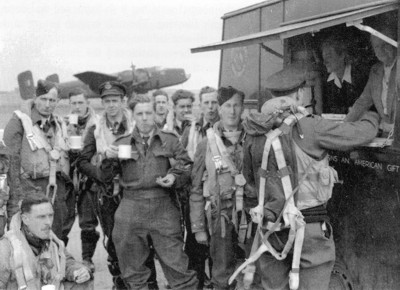
 |

After Volunteering for Aircrew and being interviewed the newly accepted cadets first posting would be to the Air Crew Recruiting Centre (ACRC) such as Lords Cricket Ground London. Service life started here. Initial training followed then a posting to the Aircrew Despatch Centre (ACDC), Heaton Park, Manchester. Here the trainee pilots and navigators would wait until a troopship could take them to Canada or Rhodesia to continue their training. The wait could be many months and the trainees needed to be occupied. Some went to farms where they were really put to work. Others were sent to operational bases. Bill Williams. RAFVR 1609792 was sent to Burn in August 1944.
Bill Williams takes up the story:
Perhaps you wondered what a group of u/t pilots were doing at Burn?. We had all completed ITW and had been to EFTS to be graded as Pilots, Bombaimers or Navigators. Some of us had even spent months at a Pre-Aircrew Training Course - I did mine at the Wandsworth Technical College. We had then been returned to ACRC at Heaton Park in Manchester. I presume there were far too many of us so they had to think of a scheme to "farm" us out to various stations. I believe some were transferred to be trained as glider pilots. I applied to be remustered as a Wop/AG but they would not entertain it. Probably saved my life. I eventually ended up in the Rhodesian Air Training Scheme traveling by ship from Liverpool to Alexandria and then flying from Heliopolis to Southern Rhodesia. A real Cook's tour. Other went to Canada and South Africa. I was flying Harvards at Thornhill (Gwelo) when the war ended. We were never told what was going on. Had a lovely 6 weeks in Cape Town waiting for a troop ship to take us back to the U.K
I arrived at Burn in August 1944 and stayed until November. One of my jobs was to collect night gen folders and windows (metalised strips) to confuse the German radar, from Snaith and also from Pocklington. Apart from the loss of the two Halifaxes on 11th September I remember that there were two midair collisions involving four aircraft on 21st September and 18th November. No survivors. We were entertained by Ensa and the Bomber Command Band. Selby was within walking distance and the "natives" were very friendly. I worked in Flying Control, refueling and the Bomb Dump in fact anywhere they needed a spare "bod". The pubs nearby included The Wheatsheaf, The Sloop, the Grey Horse at Drayton and the Griffin. The only church I remember is St. Mary's. A couple of dance halls at St. Mary's and the Labour Hall. Cinemas included the Ritz the Hippodrome and the Central. The above photo was taken at "B" Flight on 12th October. (I am at the end, front row, far left). The Station must have had a very good catering Officer as we were very well fed. Also a good Naafi and tea and "wads" wagons manned by local WVS and Sally Anne volunteers. All in all not a bad place to be at that time.

After Burn I also served at Syerston (HCU) Lancasters which had passed their sell by date. More crashes!. My last posting before leaving England to go to Rhodesia was at Tain, Rosshire. Liberators of Coastal Command. I was one of the lucky ones and survived the war intact in body, if not in mind!. I re-enlisted in the VR in 1949 and served part time at No.10 RFS, Exeter flying Tiger Moths and Chipmunks. Had my last flight as a pilot in Nairobi in 1963 when I took my wife for a farewell trip over the Rift Valley before we left for South Africa.
"The one thing about Burn that sticks in my mind is that Selby had more pubs than churches!!. Lovely girls too"
source: ‘Bill Williams. RAFVR 1609792'